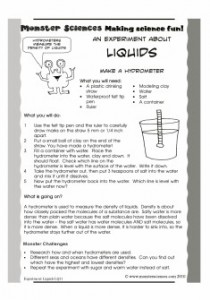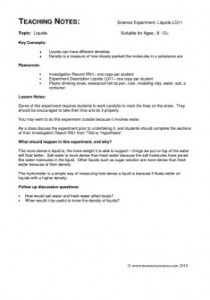Learn more about the density of liquids by making your own hydrometer and testing it.
 |
 |
A Monster Sciences Experiment about Liquids: Make a hydrometer
What you will need:
- A plastic drinking straw
- Waterproof felt tip pen
- Ruler
- Modeling clay
- Water
- Salt
- A container
What you will do:
- Use the felt tip pen and the ruler to carefully draw marks on the straw 5 mm or 1/4 inch apart.
- Put a small ball of clay on the end of the straw. You have made a hydrometer!
- Fill a container with water. Place the hydrometer into the water, clay end down. It should float. Check which line on the hydrometer is level with the surface of the water. Write it down.
- Take the hydrometer out, then put 3 teaspoons of salt into the water and mix it until it dissolves.
- Now put the hydrometer back into the water. Which line is level with the water now?
What is going on?
A hydrometer is used to measure the density of liquids. Density is about how closely packed the molecules of a substance are. Salty water is more dense than plain water because the salt molecules have been dissolved into the water – the salt water has water molecules AND salt molecules, so it is more dense. When a liquid is more dense, it is harder to sink into, so the hydrometer stays further out of the water.
Monster Challenges:
- Research how and when hydrometers are used.
- Different seas and oceans have different densities. Can you find out which have the highest and lowest densities?
- Repeat the experiment with sugar and warm water instead of salt.
Teaching Notes: Monster Sciences Experiment: Liquids LQ11
Topic:
Liquids
Key Concepts:
- Liquids can have different densities
- Density is a measure of how closely packed the molecules in a substance are
Resources:
- Investigation Record IR01– one copy per student
- Experiment Description Liquids LQ11– one copy per student
- Plastic drinking straw, waterproof felt tip pen, ruler, modeling clay, water, salt, a container
Lesson Notes:
Some of this experiment requires students to work carefully to mark the lines on the straw. They should be encouraged to take their time and do it properly.
You may want to do this experiment outside because it involves water.
As a class discuss the experiment prior to undertaking it, and students should complete the sections of their Investigation Report IR01 from ”Title to “Hypothesis”.
What should happen in this experiment, and why?
The more dense a liquid is, the more weight it is able to support – things we put on top of the water will float better. Salt water is more dense than fresh water because the salt molecules have joined the water molecules in the liquid. Other liquids such as sugar solution are more dense than fresh water because of their density.
The hydrometer is a simple way of measuring how dense a liquid is because it floats better on liquids with a higher density.
Follow up discussion questions:
- How would salt water and fresh water affect boats?
- When would it be useful to know the density of liquids?
Get this experiment here or as part of a bundle of Experiments about Liquids here.



